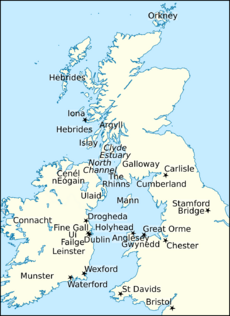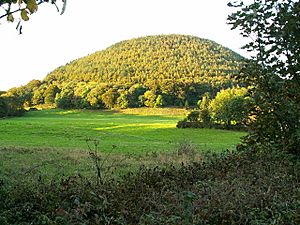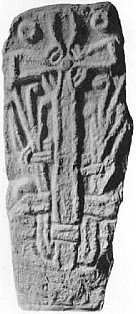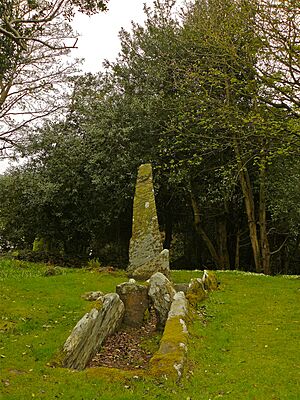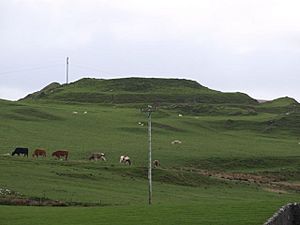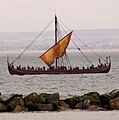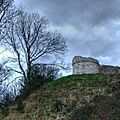Godred Crovan facts for kids
Quick facts for kids Godred Crovan |
|
|---|---|
| King of Dublin and the Isles | |

Godred's name as it appears on folio 50v of British Library Cotton Julius A VII (the Chronicle of Mann): "Godredus Crouan"
|
|
| Died | 1095 Islay |
| Burial | possibly Iona |
| Issue | Lagmann, Aralt, Amlaíb |
| House | Crovan dynasty (Uí Ímair) |
| Father | Harald "The Black” of Islay (Harallt Ddu) |
Godred Crovan (died 1095) was a powerful Norse-Gaelic ruler. He became King of both Dublin and the Isles. His family, the Uí Ímair, were important rulers in the region. Godred was a descendant of Amlaíb Cúarán, King of Northumbria and Dublin.
Godred first appeared in history helping Norway invade England in 1066. After this failed, he went to the Mann. There, he stayed with Gofraid mac Sitriuc, the King of the Isles. Godred likely took over the kingship of the Isles in the 1070s. By 1091, he also became King of Dublin. This gave him control over important trade routes in the Irish Sea. His rule brought peace to Mann.
Template:TOC limit=3
Contents
Who Was Godred Crovan?
Godred Crovan's exact family history is a bit unclear. But we know he was part of the important Uí Ímair family. This means he was related to Amlaíb Cúarán, a famous king of Northumbria and Dublin.
His father was likely Harald "The Black" of Islay. The name "Crovan" might mean "white-handed" or "pale-blooded" in Gaelic. It could also mean "cripple" in Old Norse. In some Irish records, he is called "meranach," which might mean "mad" or "giddy." It could also refer to his hands.
Godred's family, the Crovan dynasty, ruled the Isles for about 200 years. Their mix of Norse and Gaelic names shows how these cultures blended in the Kingdom of the Isles.
Godred's Early Life and Rise to Power
Godred started his career as a fighter for hire. The Chronicle of Mann says he fought in the Norwegian invasion of England in 1066. This invasion ended badly at the Battle of Stamford Bridge. The Norwegian army was completely defeated.
After this battle, Godred escaped to Mann. He found safety with King Gofraid mac Sitriuc. They were probably relatives. Godred's decision to go to Mann, not Dublin, might be because Dublin was allied with the English king.
King Gofraid mac Sitriuc died in 1070. His son, Fingal, became king. Around 1075 or 1079, Godred conquered Mann after three sea invasions. He might have taken advantage of Fingal's weakness.
Godred's main power base was likely in the Hebrides. After conquering Mann, he offered his followers a choice. They could either plunder the island or settle there. Only a few of his men stayed. Godred gave them land in the south of Mann. He let the native people keep land in the north. But they had to give up their rights to own it forever. This act, according to the chronicle, meant Godred's family later owned the whole island.
Archaeological finds on Mann show that the island became more peaceful after Godred took over. This suggests his rule brought stability.
Controlling Dublin and Irish Sea Trade
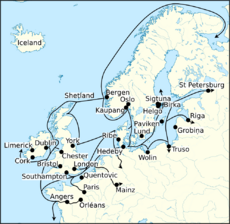
In 1091, Godred conquered the Kingdom of Dublin. The Annals of Tigernach calls him "King of Dublin." The Chronicle of Mann says he took over Dublin and much of Leinster. Dublin was one of the richest ports in Western Europe. It was the most important city in Ireland by the late 11th century.
There were three main trade routes in the Irish Sea:
- From southern Wales to southeastern Ireland.
- From northern Wales to Mann and then to Dublin.
- A route going north to Iceland, Orkney, and Scandinavia.
Godred's control of Dublin meant he controlled these vital trade routes. This gave him great wealth and power. The Chronicle of Mann says Godred was so powerful at sea that he controlled shipbuilding. He made sure no one built ships with more than three bolts. This likely limited the size of other ships.
Godred's growing power in the Irish Sea also affected mainland politics. The English king, William II, might have taken control of Cumberland in 1092 to protect his western coast. This was likely a response to Godred's power in Dublin.
Church Leaders in the Isles
Not much is known about the early church in the Isles. The Chronicle of Mann starts listing bishops around Godred's time. The first bishop mentioned is Roolwer. His name might be an Old Norse name, Hrólfr. He was bishop before or at the start of Godred's rule.
Another important church leader was Dúnán. He is often thought to be the first Bishop of Dublin. But some records call him "high-bishop of the Foreigners." This might mean he had church power beyond Dublin. He might have been Roolwer's predecessor in the Isles.
When Dúnán died in 1074, Dublin and the Isles might have become separate church areas. Roolwer's successor was William. His name suggests he might have been from England or France. This shows Godred's connections to the wider Anglo-Norman world.
Godred's Help in Wales

Godred also helped Gruffudd ap Cynan, King of Gwynedd, a Welsh ruler. Gruffudd was fighting rivals and English nobles in northern Wales. Gruffudd was born in Dublin and was also a descendant of Amlaíb Cúarán. This shared family history might explain their alliance.
After being captured for over ten years, Gruffudd escaped. He sought military help from a king in the Isles named "Gothrei." This was likely Godred. Godred gave Gruffudd a fleet of sixty ships. With this help, Gruffudd invaded Anglesey and defeated the Anglo-Normans.
They likely attacked the Anglo-Norman castle of Aberlleiniog on Anglesey. The English had built castles along the Welsh coast. These castles were a threat to Norse-Gaelic raids. This might be why Godred helped Gruffudd.
Godred's Downfall and Death
Godred's rule in Dublin ended in 1094. He faced a northern Irish alliance, including Godred. Muirchertach Ua Briain, King of Munster, marched on Dublin. Godred's fleet had ninety ships. Muirchertach's forces were first pushed back. But he soon returned and drove Godred from Dublin.
Godred had allied with Muirchertach's rival for the high-kingship, Domnall Mac Lochlainn, King of Cenél nEógain. This alliance might have helped Godred's success in Dublin. But when Muirchertach was free from other conflicts, he took Dublin back.
After Godred's death, Dublin's coins became much worse in quality. This might show that Muirchertach's rule was not as good for trade as Godred's.
Many parts of Europe suffered from plague and famine in the early 1090s. In 1095, about a quarter of Ireland's people died from disease. Godred was one of them. He died on Islay. This might mean Muirchertach also drove him from Mann. Or it could mean Islay was an important place for Godred.
After his death, Godred was called "King of Dublin and of the Isles." This rare title shows how important he was. It highlights his achievement of expanding his power from the Isles into Ireland. He was likely buried on the holy island of Iona.
Godred's Lasting Impact
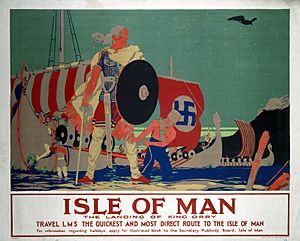
Godred's biggest impact was founding the Crovan dynasty. This strong family of sea-kings ruled the Isles for almost 200 years. They ruled until the mid-13th century, when the kingdom was taken by Alexander III, King of Scotland.
After Godred died, his family faced problems. His eldest son, Lagmann, became king. But he had to fight rivals, including Godred's younger sons. This led to political trouble. Eventually, Magnús Óláfsson, the King of Norway, took control of the Isles.
The Crovan dynasty regained power around 1120 with Amlaíb, Godred's youngest son. Later, the Isles were split between two groups. One was Godred's grandson, Gofraid mac Amlaíb. The other was Somairle mac Gilla Brigte, Lord of Argyll, who married Godred's granddaughter. Somairle eventually took over the whole kingdom. Even after the Crovan dynasty ended, Somairle's family, Clann Somairle, ruled parts of the Hebrides for centuries.
Godred in Manx Stories
Godred's arrival on Mann is often seen as the start of Manx history. He is the ancestor of later kings. He is also likely the real person behind the legendary King Orry (Manx Gaelic Ree Gorree).
King Orry appears in early Manx stories. These stories say he arrived on Mann and created the island's legal system. They also say 13 of his descendants ruled after him. This number matches the actual number of kings from the Crovan dynasty. The phrase "in King Orryes Days" was used in Manx law in 1422. It meant "a very long time ago."
On Islay, local stories say Godred's grave is marked by Carragh Bhàn. This is a prehistoric standing stone. On Mann, other prehistoric sites are also linked to King Orry's burial.
A ruined fortress on Islay, Dùn Ghùaidhre, is also linked to Godred. A ridge nearby is called "Ridge of the King" in Gaelic. Stories say Godred killed a dragon near the fortress. Another nearby place, Conisby, means "king's farm" in Old Norse. This suggests a royal connection.
Godred has also appeared in poems and songs. The 18th-century poet Thomas Chatterton wrote a poem called Godred Crovan. A Manx Gaelic song, Fin as Oshin, features a hero named Gorree/Orree. This hero likely represents Godred. Another song, Birlinn Ghoraidh Chróbhain, describes Godred's royal ship. It celebrates the sea power of his dynasty.
Godred also appears in the fictional history of The Island of Sodor from The Railway Series (where Thomas & Friends is set). A station there, Crovan's Gate, is named after him. In the books, it was the site of a battle involving Godred Crovan.
Images for kids
-
Romanticised nineteenth-century depiction of Godred Crovan. Vikings were first associated with unhistorical horned helmets early that century.
-
Romanticised nineteenth-century depiction of Godred Crovan. Vikings were first associated with unhistorical horned helmets early that century.
-
A depiction of English infantry and Norman cavalry on the eleventh-century Bayeux Tapestry. In the course of his career, Godred appears to have battled both Anglo-Saxon and Anglo-Norman forces. The depicted infantry are shown formed in a shield wall, a tactic employed by the Norwegian-backed forces at Stamford Bridge.
-
Maughold IV (image a), a Manx runestone displaying a contemporary sailing vessel. The power of the kings of the Isles laid in their armed galley-fleets
-
Maughold IV (image b), a contemporary sailing vessel. The power of the kings of the Isles laid in their armed galley-fleets
-
Skuldelev II (image a), a contemporary Viking longboat uncovered in Denmark, was originally built of oak from Ireland or specifically Dublin, and dates to about Godred's floruit. It may have been commissioned during the reign of Ímar mac Arailt.
-
One of several ruinous keeills in the churchyard of Kirk Maughold. According to the chronicle, Roolwer was buried at the "church of St Maughold". Whether this was the site of his cathedral is unknown.
-
Godred could well have assisted Gruffudd in attacking the Anglo-Norman castle of Aberlleiniog on Anglesey.
-
Great Orme, where Grithfridus is said to have made landfall before battling and killing Robert de Tilleul
-
The name of Muirchertach Ua Briain as it appears on folio 33v of British Library Cotton Julius A VII: "Murecardum"
-
Forms of Gofraid mac Fergusa's name as they appear on folios 13r (image a) and 320v (image b) of the seventeenth-century Dublin Royal Irish Academy C iii 3 (the Annals of the Four Masters)
-
Forms of Gofraid mac Fergusa's name as they appear on folios 13r (image a) and 320v (image b) of the seventeenth-century Dublin Royal Irish Academy C iii 3 (the Annals of the Four Masters)


